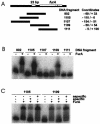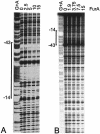Mycobacterium tuberculosis FurA autoregulates its own expression
- PMID: 12949087
- PMCID: PMC193761
- DOI: 10.1128/JB.185.18.5357-5362.2003
Mycobacterium tuberculosis FurA autoregulates its own expression
Abstract
The furA-katG region of Mycobacterium tuberculosis, encoding a Fur-like protein and the catalase-peroxidase, is highly conserved among mycobacteria. Both genes are induced upon oxidative stress. In this work we analyzed the M. tuberculosis furA promoter region. DNA fragments were cloned upstream of the luciferase reporter gene, and promoter activity in Mycobacterium smegmatis was measured in both the presence and absence of oxidative stress. The shortest fragment containing an inducible promoter extends 45 bp upstream of furA. In this region, -35 and -10 promoter consensus sequences can be identified, as well as a 23-bp AT-rich sequence that is conserved in the nonpathogenic but closely related M. smegmatis. M. tuberculosis FurA was purified and found to bind upstream of furA by gel shift analysis. A ca. 30-bp DNA sequence, centered on the AT-rich region, was essential for FurA binding and protected by FurA in footprinting analysis. Peroxide treatment of FurA abolished DNA binding. Three different AT-rich sequences mutagenized by site-directed mutagenesis were constructed. In each mutant, both M. tuberculosis FurA binding in vitro and pfurA regulation upon oxidative-stress in M. smegmatis were abolished. Thus, pfurA is an oxidative stress-responsive promoter controlled by the FurA protein.
Figures






Similar articles
-
The katG mRNA of Mycobacterium tuberculosis and Mycobacterium smegmatis is processed at its 5' end and is stabilized by both a polypurine sequence and translation initiation.BMC Mol Biol. 2008 Apr 4;9:33. doi: 10.1186/1471-2199-9-33. BMC Mol Biol. 2008. PMID: 18394163 Free PMC article.
-
Transcriptional regulation of furA and katG upon oxidative stress in Mycobacterium smegmatis.J Bacteriol. 2001 Dec;183(23):6801-6. doi: 10.1128/JB.183.23.6801-6806.2001. J Bacteriol. 2001. PMID: 11698368 Free PMC article.
-
A novel differential expression system for gene modulation in Mycobacteria.Plasmid. 2009 Jan;61(1):39-46. doi: 10.1016/j.plasmid.2008.09.002. Epub 2008 Oct 25. Plasmid. 2009. PMID: 18835406
-
Regulation of catalase-peroxidase (KatG) expression, isoniazid sensitivity and virulence by furA of Mycobacterium tuberculosis.Mol Microbiol. 2001 May;40(4):879-89. doi: 10.1046/j.1365-2958.2001.02427.x. Mol Microbiol. 2001. PMID: 11401695
-
Nutrient acquisition by mycobacteria.Microbiology (Reading). 2008 Mar;154(Pt 3):679-692. doi: 10.1099/mic.0.2007/012872-0. Microbiology (Reading). 2008. PMID: 18310015 Review.
Cited by
-
The mycobacterial LysR-type regulator OxyS responds to oxidative stress and negatively regulates expression of the catalase-peroxidase gene.PLoS One. 2012;7(1):e30186. doi: 10.1371/journal.pone.0030186. Epub 2012 Jan 17. PLoS One. 2012. PMID: 22272299 Free PMC article.
-
Functionalized Dioxonaphthoimidazoliums: A Redox Cycling Chemotype with Potent Bactericidal Activities against Mycobacterium tuberculosis.J Med Chem. 2021 Nov 11;64(21):15991-16007. doi: 10.1021/acs.jmedchem.1c01383. Epub 2021 Oct 27. J Med Chem. 2021. PMID: 34706190 Free PMC article.
-
The katG mRNA of Mycobacterium tuberculosis and Mycobacterium smegmatis is processed at its 5' end and is stabilized by both a polypurine sequence and translation initiation.BMC Mol Biol. 2008 Apr 4;9:33. doi: 10.1186/1471-2199-9-33. BMC Mol Biol. 2008. PMID: 18394163 Free PMC article.
-
Repression of antibiotic production and sporulation in Streptomyces coelicolor by overexpression of a TetR family transcriptional regulator.Appl Environ Microbiol. 2010 Dec;76(23):7741-53. doi: 10.1128/AEM.00819-10. Epub 2010 Oct 8. Appl Environ Microbiol. 2010. PMID: 20935121 Free PMC article.
-
Enteropathogens: Tuning Their Gene Expression for Hassle-Free Survival.Front Microbiol. 2019 Jan 9;9:3303. doi: 10.3389/fmicb.2018.03303. eCollection 2018. Front Microbiol. 2019. PMID: 30687282 Free PMC article. Review.
References
-
- Althaus, E. W., C. E. Outten, K. E. Olson, H. Cao, and T. V. Halloran. 1999. The ferric uptake regulation (Fur) repressor is a zinc metalloprotein. Biochemistry 38:6559-6569. - PubMed
-
- Bagg, A., and J. B. Neilands. 1987. Ferric uptake regulation protein acts as a repressor, employing iron (II) as a cofactor to bind the operator of an iron transport operon in Escherichia coli. Biochemistry 26:5471-5477. - PubMed
-
- Bsat, N., A. Herbig, L. Casillas-Martinez, P. Setlow, and J. D. Helmann. 1998. Bacillus subtilis contains multiple Fur homologues: identification of the iron uptake (Fur) and peroxide regulon (PerR) repressors. Mol. Microbiol. 29:189-198. - PubMed
-
- Bullock, W., J. Fernandez, and J. Short. 1987. XLI-Blue: a high efficiency plasmid transforming recA E. coli strain with β-galactosidase selection. BioTechniques 5:376-379.
Publication types
MeSH terms
Substances
LinkOut - more resources
Full Text Sources
Molecular Biology Databases

